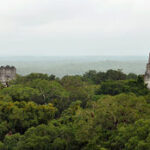From what we can learn about prehistory, it seems that very primitive people at an early date gained a remarkable knowledge of astronomy, the order of the seasons, and the development of a calendar. Of course, this knowledge is not out of this world for primitive people. It is fundamental for understanding when to plant, when to expect harvests, when to prepare for rains and floods. Even more importantly, the cycle of the seasons and years provides a basis for festivals, holidays, and other annual observances. Think of the astronomical significance of Stonehenge and the Egyptian pyramids.
It is no surprise, then, that some tribes living in the Americas before the European conquest had made considerable advances in astronomy. By close observation of the heavenly bodies they had developed a complicated and remarkably exact calendar. Not only had they determined the length of the year with greater accuracy than the white invaders, but also the different cycles by which they computed time allowed them to assign dates to events that took place many hundreds of years earlier.
Although there are local differences, the calendars in use in Central and Southern Mexico and in Central America were evidently derived from a now lost source. There is a great deal of speculation about them, but many questions about them remain unanswered. We do not understand the uses of the shorter year, of 260 days, the doubling of certain months, or the names of many days and months. Different tribes even began the year at different seasons.
In ancient times, the calendars were usually depicted by circular drawings, which the Spaniards called wheels (ruedas). After the European invasion, they were written out, more like an almanac.
One importance use of the calendar was for supplying omens and predictions; another was for determining fasts, festivals, and religious rituals. We do know that in some cultures, the calendar was referred to as “the book of days” or “that by which events are arranged.” So intimately were all the acts of individual and national life bound up with their religious beliefs, that an understanding of them is indispensable to a successful study of the psychology and history of first people in the Americas.
After the European invasion, as the native peoples adopted some of the beliefs of the newcomers, such as astrology, the Christian calendar (including saints days, festivals of the Virgin Mary, Lent, Easter and Christmas), and the concept of the week (which has no basis in nature) were absorbed into the native calendars, which began to display lucky and unlucky days (somewhat like the horoscopes in our modern newspapers), and discussions of planetary influence, apparently borrowed from the European almanacs.



